The pilgrimage journey to visit The Shikoku 88 Temple. In Naruto, the "place where it all began," there is a landscape that connects people's prayers and thoughts. This time, we will trace the spiritual journey of the pilgrim through the story of a pilgrim who visited from Italy.
2025.11.27Naruto City is home to the first temple of The Shikoku 88 Temple, Ryozenji Temple , and the second temple, Gokurakuji Temple.
This is the "place of origin" of the pilgrimage, which has a history of 1,200 years, and is a town where people's prayers and journeys still live on.
Pilgrims set out from in front of the gate on a clear autumn day, friends rejoicing at their reunion, voices of "have a good trip" echoing, and the natural pulse of the whirlpools.
Through the story of a pilgrim from Italy, we trace the origins of the "journey of the heart" that Naruto has witnessed.
-
Table of Contents
- Part 1: The "Path of Prayer" that Connects the World - A Pilgrimage Beginning in Naruto
- Part 2: A Prayer for Continuing to Walk: The Beginnings and Present of the Shikoku Pilgrimage
- Part 3: Guided by the scent of osmanthus
- Part 4: The town of "See you later" - Naruto's history as a pilgrim
Part 1: The "Path of Prayer" that Connects the World - A Pilgrimage Beginning in Naruto
On November 1, 2025, 20 members of "Walking with Autism (In Cammino con L'autismo)" from Italy visited Naruto. They are a group that walks pilgrimage routes around the world to convey the image of people with autism living together in society. They have walked pilgrimage routes around the world, including Santiago in Spain and Via Francigena in Italy. Having been captivated by the warmth of the Shikoku Pilgrimage, which they attempted for the first time two years ago, they returned to this place again.
At Monzen Monzen Ichibangai selling pilgrimage supplies and souvenirs in front of the first temple, Mount Ryozen , locals greeted us with smiles and a "Welcome back!" The members' eyes lit up as they reunited with members and shop owners of the Tokushima Prefecture Autism Association, whom they had interacted with on their previous trip. People from different countries and languages smiled and held hands. Such warmth is the greatest charm of Naruto, the starting point of this pilgrimage.
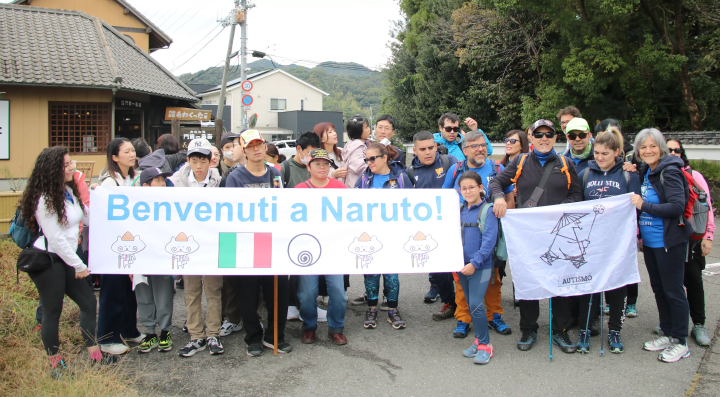
Pelangelo Cappai, representative of Walking with Autism, said, "The Shikoku Pilgrimage, which we experienced for the first time two years ago, had a huge impact on our lives. It was not just an adventure or a pilgrimage, but a journey of true encounters. The opportunities to confront ourselves, the wonder of travel, Japanese culture, and the encounters with the warm welcome we received are etched in our hearts."
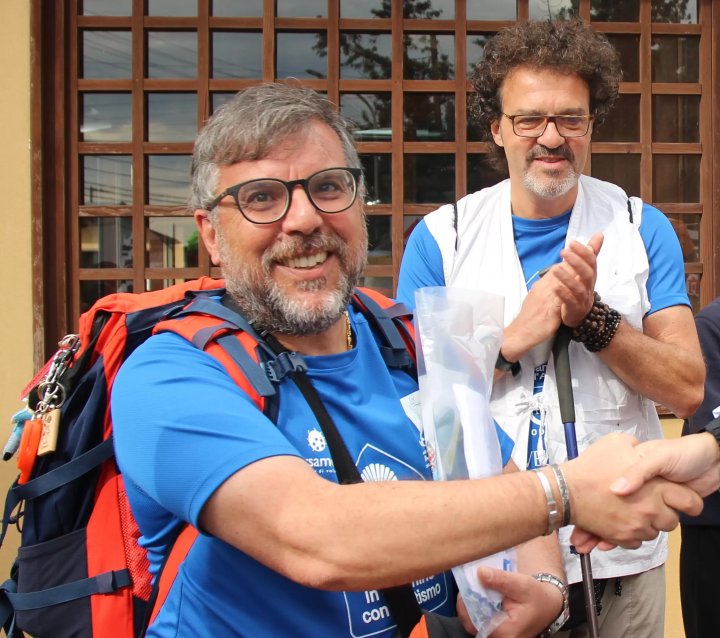
"Each temple we visited was a place where we felt a real sense of accomplishment and growth. Not only did we overcome difficulties, but we also felt great joy in walking together and supporting each other as we made progress little by little. Japan also taught us a lot. The careful attention to detail in everyday life, the harmonious atmosphere, and the deep consideration for others that we felt everywhere made us feel warmly welcomed and valued. We were not just travelers, but each of us was recognized for our individuality. The experience of experiencing Japan's warmth and tolerance has become something precious that will stay with me forever."
They later walked pilgrimage routes around the world, but the scenery of the Shikoku Pilgrimage and the smiles of the people they walked with never faded from their memories. And so they returned to this place. Kappai says, "We decided to attempt The Shikoku 88 Temple Pilgrimage once again. I believe that through the Shikoku Pilgrimage, you can become spiritually enriched by accepting yourself and acknowledging your differences, and that walking with others can make you stronger. Pilgrimage is like a microcosm of life, a path of growth as you face difficulties and surprises. This journey also conveys that autism and diversity are not disabilities, but ways to see the world from a new perspective. Through this journey, we hope to expand our connections with many different people and deepen our mutual understanding."
Shima Yuko, president of the Tokushima Prefecture Autism Association, who attempted the pilgrimage with them two years ago, expressed her joy at the reunion, saying, "The moment we saw each other's faces on the other side of the crosswalk, we both immediately smiled. I'm happy to see them again."
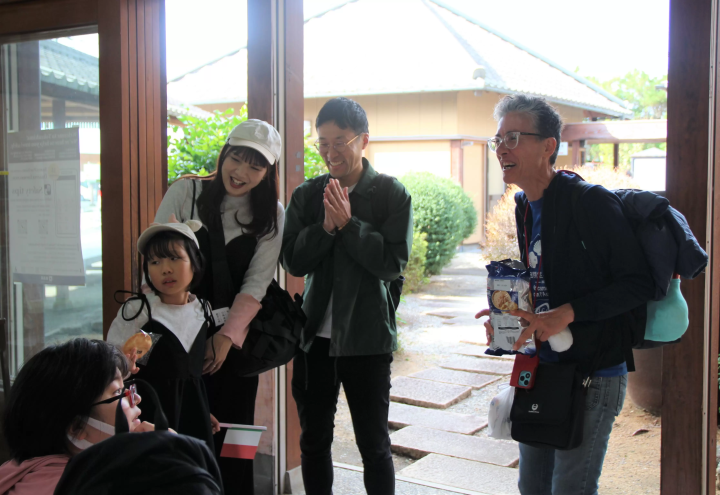
The starting point of The Shikoku 88 Temple is the first Ryozenji Temple. Passing through the gate bathed in the morning light, they slowly make their way forward. They ring the bell, light candles, and pray quietly. Their appearance is very dignified and calm.
As soon as we left the first temple, we heard the voices of children coming from the window of a house along the road.
"Good morning. Have a nice day!"
The other members responded with a laugh, "Thank you!"
They waved to each other. In that brief exchange, the spirit of "Osentai" (hospitality) that lives on in this land was felt. Seeing off and supporting strangers as if they were family - this is a culture that connects people that has continued in this land since ancient times.

The Shikoku Pilgrimage is a journey of prayer that visits the 88 sacred sites where Kobo Daishi, or Kukai, practiced asceticism approximately 1,200 years ago. The first step on this journey begins here in Naruto. The pilgrimage is not only a journey of faith, but also a journey of self-reflection.
The group continues walking towards the next temple, and soon the faint scent of osmanthus begins to waft through the air.
--The autumn pilgrimage route, enveloped in gentle fragrances, quietly guides their hearts.
[End of Part 1]
Part 2: A Prayer for Continuing to Walk: The Beginnings and Present of the Shikoku Pilgrimage
The Shikoku Pilgrimage is a grand circular pilgrimage route spanning 1,400 kilometers around the entire island of Shikoku, visiting 88 temples associated with Kobo Daishi Kukai, scattered across Awa ( Kochi Prefecture ), Tosa ( Ehime Prefecture ), Iyo ( Kagawa Prefecture), and Sanuki (Kagawa Prefecture).
◇ Shikoku Pilgrimage, a 1,200-year-old pilgrimage nurtured by the rich natural environment of Shikoku

The history of the Shikoku Pilgrimage began in the Heian period with pilgrimages by monks and ascetics to the sacred sites where Kobo Daishi is said to have practiced, and in the Kamakura period, Saigyo, Honen, and Ippen are also said to have visited Shikoku. Gradually, ordinary people began to make the pilgrimage, and with the development of maritime transportation in the Edo period, pilgrimages to remote locations became more popular. As faith in Kobo Daishi spread, Shikoku itself, where Kobo Daishi is said to have been born, practiced, and attained enlightenment, came to be regarded as a sacred place and spread among the general public. Today, pilgrims are made by public transportation such as buses, trains, and private cars, but many people still make the pilgrimage on foot. The Shikoku Pilgrimage has been passed down for over 1,200 years, undergoing changes over the years, and is continually carried out by people.
The sight of pilgrims dressed in white robes and sedge hats, carrying kongo staffs, coming and going along steep mountain paths known as "henro korogashi" that retain the atmosphere of the past, long stone steps, tranquil countryside, bustling towns, calm seasides, and remote capes is a seasonal feature of the Shikoku pilgrimage. The expressions of the pilgrims on their long journey are filled with a sense of fulfillment and peace, and the sound of their kongo staffs tapping the cobblestones resonates lightly, and the scenery, which blends into the great nature of Shikoku together with the sound of bells, is truly refreshing.
◇A long-distance circular pilgrimage route that represents Japan
Unlike Christian and Islamic pilgrimages, which aim for a final destination, the Shikoku Pilgrimage is a long-distance circular pilgrimage that spans the entire island of Shikoku and is representative of Japan. Visiting all of the temples on foot takes more than 40 days, and the pilgrimage route is named after the spiritual growth of the individual: Awa solidifies their resolve to practice; Tosa is the "Dojo of Training" where one faces oneself and struggles; Iyo is the "Dojo of Bodhi" where one is freed from doubt; and Sanuki is the "Dojo of Nirvana" where one attains fulfillment of one's aspirations and enlightenment.
However, it is not necessary to make the pilgrimage to all the temples at once. Each temple is considered equally important, and you can start from any one place. There are many ways to make the pilgrimage, such as visiting the temples in several parts ("Sekiri-uchi"), visiting the temples in four parts (Awa, Tosa, Iyo, and Sanuki) ("Ikkoku-mairi"), visiting the temples in reverse order ("Gyaku-uchi"), or visiting the temples in any order ("Randome-uchi"). Many people make the pilgrimage multiple times.
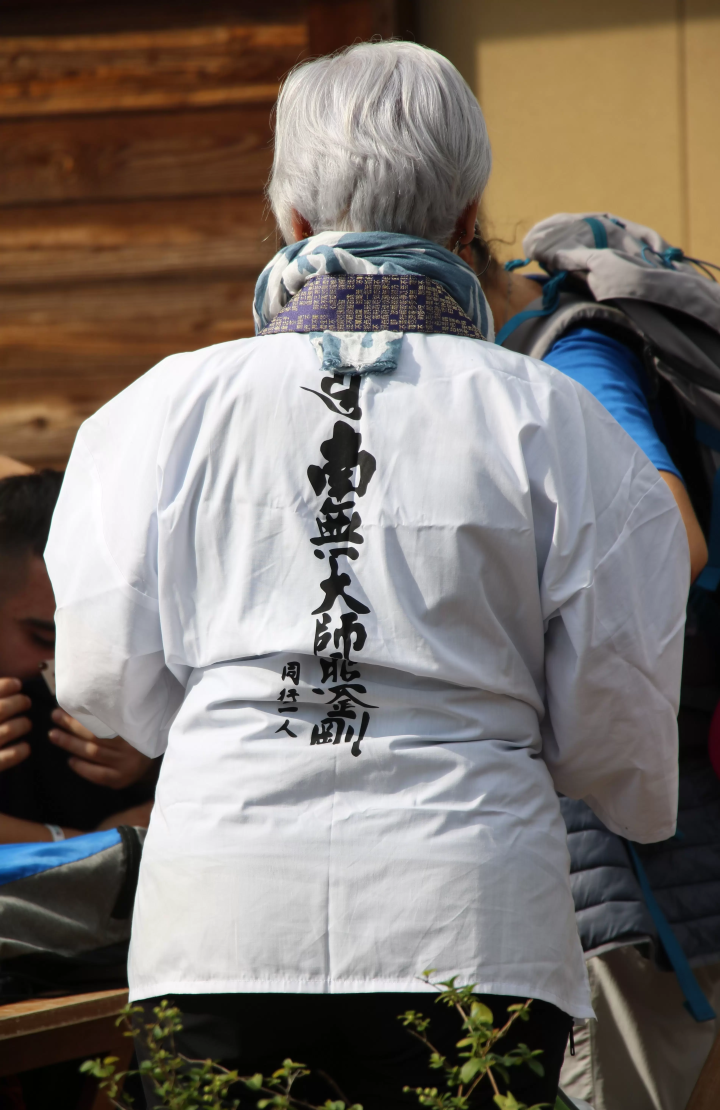
On the Shikoku Pilgrimage, anyone can become a pilgrim, regardless of nationality, religion, or sect, and together with Kobo Daishi, they travel together as a "companion couple" (dogyo ninnin), seeking "salvation" or "healing," or perhaps "memorial service" or "training," and each with their own thoughts in mind, they head towards the next temple one step at a time, continuing on a "journey of the heart" in which they come face to face with themselves.
◇The "Osentai" culture that unites the community to support the Shikoku Pilgrimage
The people of Shikoku, regardless of age or gender, have long regarded pilgrims as familiar faces, warmly welcoming and watching over them, offering a unique form of assistance known as "osettai." They offer pilgrims food, fruit, and drinks, offer words of encouragement, guide them when they get lost, and sometimes provide them with free lodging and baths known as "zenkonyado." It is said that "by providing osentai, they entrust the pilgrimage to the pilgrims on their behalf," or that "osentai itself is a meritorious act."
Through their interactions with local residents and casual remarks, pilgrims are soothed from their physical and mental fatigue, given new energy, and are inspired to continue their pilgrimage again even when they feel like giving up halfway through.The biggest difference between Shikoku pilgrimage culture and the pilgrimage culture of other religions is that Shikoku pilgrimage is integrated into the lives of the people of Shikoku, and the people are always close to the pilgrims, and the symbol of this is "hospitality."
Shikoku Pilgrimage: A Living Cultural Heritage Weaving Faith, Training, and Region
The Shikoku Pilgrimage is a unique pilgrimage culture that combines faith in Kobo Daishi, a place to practice asceticism, and the community that supports it; it is also a living cultural heritage that passes on our country's history, culture, and the spirit of the Japanese people.
*Created by processing the Japan Heritage Portal Site (Agency for Cultural Affairs) ( https://japan-heritage.bunka.go.jp/ja/ )
| Another Story |
| Naruto Symphony No. 9 - A symphony for peace resonating in the land of Bando |
June 1, 1918. The complete Beethoven Ninth Symphony was performed for the first time in Asia by German prisoners of war at the Bando Prisoner of War Camp in Naruto City , Tokushima Prefecture .
The background to the premiere was historical fact, which embodied the spirit of humanity inherent in the "Ninth Symphony," including the humane treatment of prisoners by the camp's staff, including the camp director, Matsue Toyohisa, and the heartwarming exchanges that transcended borders between the prisoners and the local people. It is said that there was also a widespread trend among the local people to call the prisoners "Mr. Germany, Mr. Germany," and to become close to them like family. Bando was also the first temple on the Shikoku Pilgrimage. The ancient customs of hospitality and zenkon-yado (lodgings for philanthropy) have unconsciously continued to live on in the hearts of the people, and there seems to have been little resistance to accepting foreign soldiers.
Just as Beethoven borrowed Schiller's poem to portray human love, the Naruto Ninth is a unique asset born from Naruto City, and at a time when the flames of war continue to rage on the planet, it is also a "Symphony of Peace" that transcends national borders and is sent out to the world.
[End of Part 2]
Part 3: Guided by the scent of osmanthus
On the way to the second temple, the group stopped at a park. The site of the former Bando Prisoner of War Camp is now German Village Park. German soldiers held here as prisoners of war during World War I developed relationships with the local residents, and they developed mutual respect through music, bread-making, sports, and more. This is a history of accepting and living together with those who were supposed to be "enemies."Naruto has long been home to an inclusive culture that accepts differences as they are.
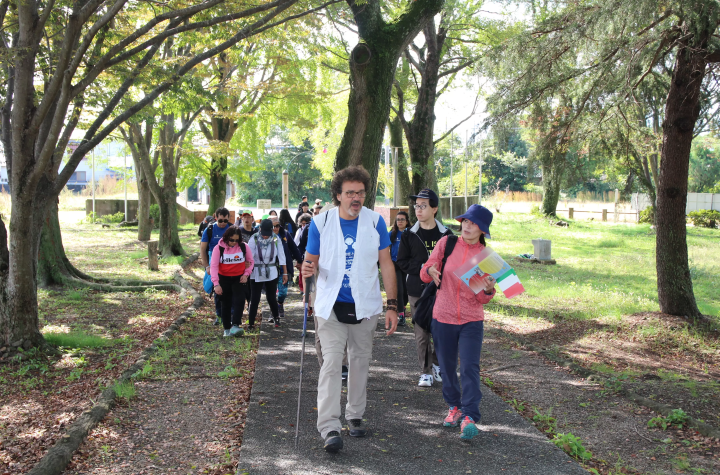
Passing through the vermilion-lacquered Niomon Gate of Gokurakuji Temple, the second temple of the pilgrimage, the group took in the silence and majesty of the temple grounds, and began to think about their journey anew.
Chairman Kappai reiterated the significance of this pilgrimage: "My son Federico was deeply moved by his experience here two years ago, and it had such an impact that he started studying Japanese after returning home. This time, I saw him naturally bow at the temple gate and follow the proper etiquette when praying, and I realized how much he has grown since the last time. As a parent, it is truly moving to see my son gaining enrichment in both body and mind through the pilgrimage. The warm encouragement from the local people has also touched my heart, and every time I visit this place I feel the warmth of the bonds between people. I will cherish this experience and plan to return many times in the future."
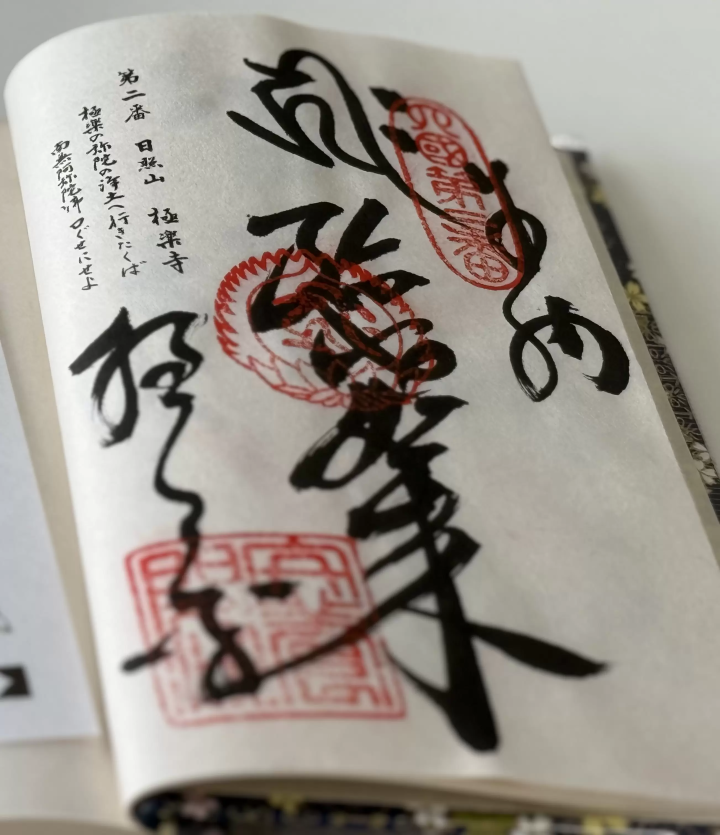
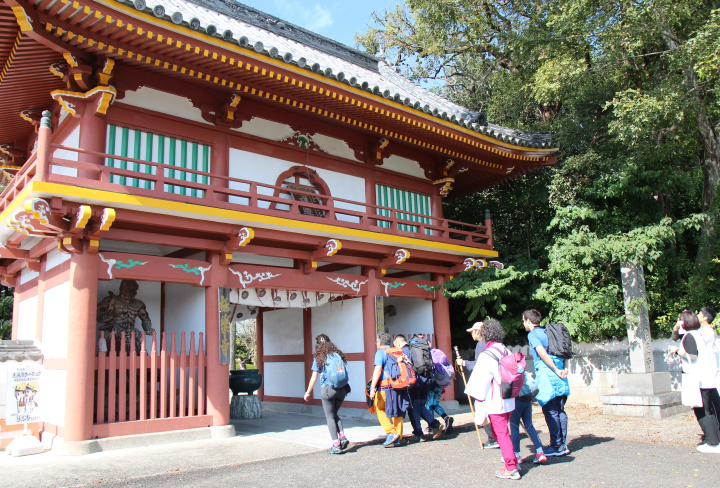
Chairman Shima also expressed his hopes for continued exchange, saying, "Even though there are differences in culture and language, we are able to move forward while helping each other through gestures and emotional exchanges. There were many occasions on this trip where we felt this connection, and there was joy in being able to connect our hearts even over small things. We would like to continue to cherish this connection in the future."
Starting from the second temple, Gokurakuji, the pilgrims begin their full-scale walk along the pilgrimage route. Under the soft autumn sunlight, they proceed quietly in a line.

Along the way, the scent of sweet osmanthus drifts from nowhere. They take one step at a time, guided by the sweet, nostalgic, and somewhat sad scent. Every time the scent fades, a new breeze brings it in. It is as if the land itself is gently encouraging them.

By the time we reached the third temple, Kinsenji, a pleasant fatigue had settled over us. We had lunch and took commemorative photos. We exchanged smiles and started walking again. But soon a cold wind began to blow and the sky turned gray. A heavy rain began to fall. It was an unexpected rain. But no one panicked.
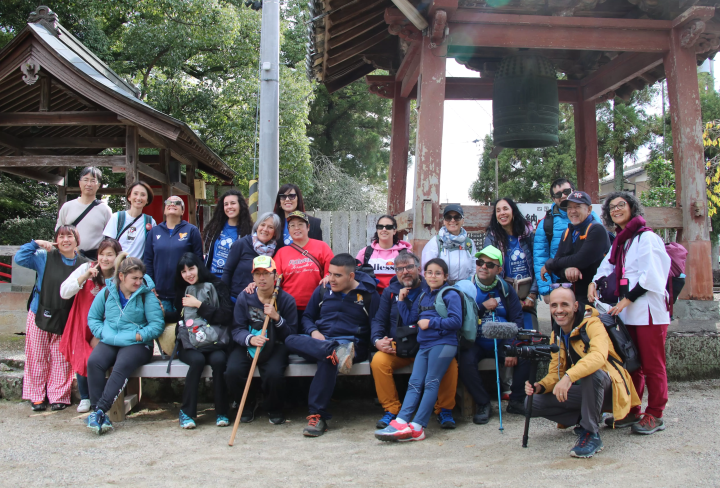
They take shelter from the rain under the eaves of a nearby house. The residents ask, "Where are you from?" "We're from Italy." "Thank you for coming all the way here. Please be careful." "Thank you." Their hearts are warmly warmed by the warm interactions they have had in this unfamiliar land.
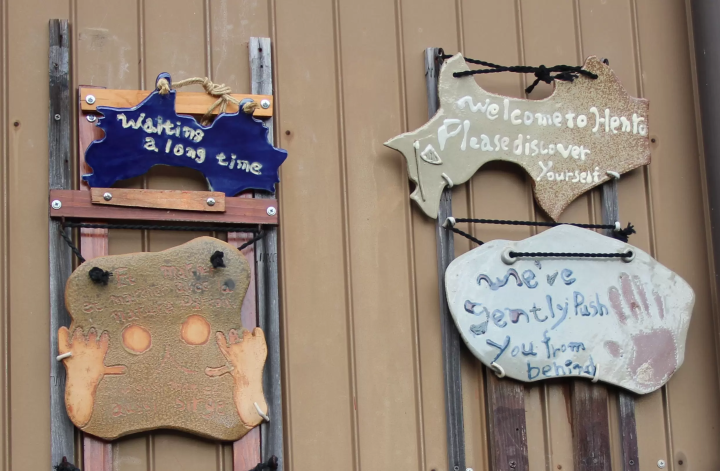
I understand what Kappai means when he says, "Pilgrimage is like a microcosm of life."
--If it rains, just take shelter. If you're tired, just rest. Everyone has their own reasons for walking, and their own walking speed. But that's okay. --
The rain subsides, and I put on my raincoat and begin walking. The pilgrimage path is muddy, and my feet get caught in the mud. I go up and down, slipping in the mud, but I keep moving forward. This, too, is like life. There are days when things don't go as planned, and there are days when light suddenly shines through.
Eventually, by the time we reached the fourth temple, Dainichi-ji, the sun began to shine through the clouds. The wet road sparkled, and the light filtering through the leaves of the trees enveloped us. Along with the fatigue of walking through the rain, a quiet sense of accomplishment spread through our hearts.


The journey for the day ended here. "Ciao!" We congratulated each other on our good efforts and shook hands with smiles. As we parted, we promised to walk together again, and these words echoed quietly on the autumn breeze.
The scent of Osmanthus fills the air once again. Like the journey of life, the pilgrimage route continues. The Shikoku Pilgrimage warmly embraces all who walk it, allowing everyone to continue their spiritual journey at their own pace.
--It is this inclusive kindness that continues to attract people from all over the world.
[End of Part 3]
Part 4: The town of "See you later" - Naruto's history as a pilgrim
Ryozenji Temple is the first of The Shikoku 88 Temple . In front of the temple gate, there are shops selling white robes, sedge hats, and prayer books, and they see off pilgrims from all over the world as they set off. Naruto is truly the "place where the pilgrimage began."
In one corner of the Monzen Ichibangai Ichibangai, where a shop has been set up for over 30 years. Mamiko Morishita, the owner of the shop that sells pilgrim supplies and local souvenirs, and who has looked after the walking pilgrims of "Walking with Autism," has seen off many pilgrims. When travelers in white robes pass through the gate, Ms. Morishita always quietly says, "Have a nice trip."
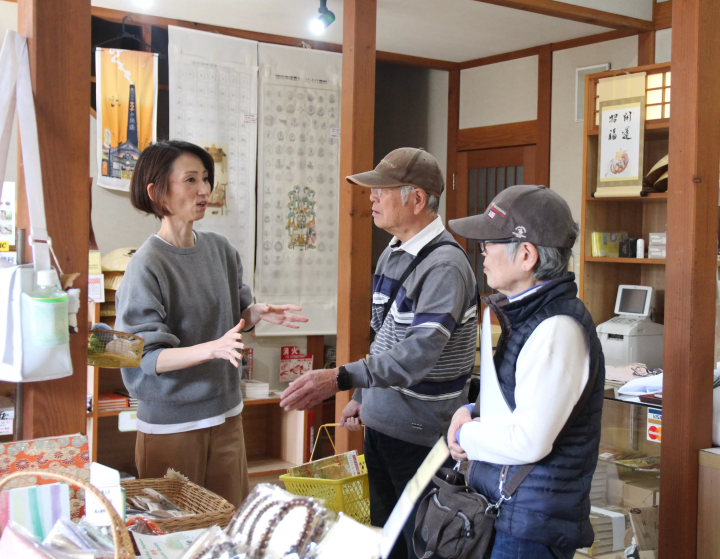
"Some people look nervous, some are smiling, and some are troubled. Everyone sets off with their own thoughts in mind. All I can do is send them off with a message of "be careful." But I'd be happy if that message helps them travel with peace of mind. I want this to be that kind of place."
These kind words encourage many people to start the pilgrimage. The culture of "Osentai" (hospitality) that is deeply rooted in the hearts of the people of Naruto continues to support the hearts of travelers.
"Osettai is not just about giving gifts. It's a feeling of respect, where you respect the other person for who they are. That's why it can be understood by people of any country. You can understand each other even if you don't speak the same language."
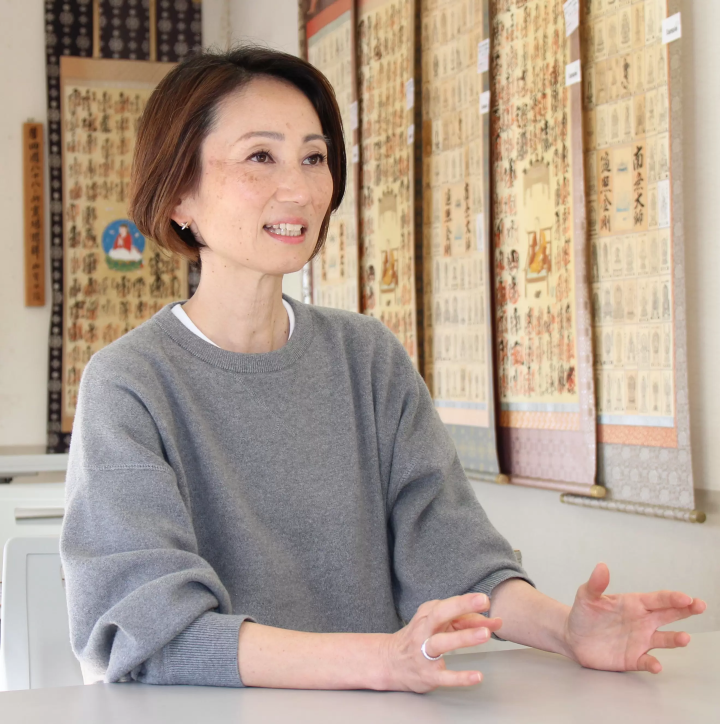
In recent years, the number of pilgrims from overseas has increased, and the scenery in front of the temple has become even more international. The word "inclusive" is increasingly heard, and the importance of comprehensive efforts that transcend differences in culture, race, and values is often discussed. However, the Shikoku Pilgrimage has in fact embodied this inclusive spirit for 1,200 years. "Regardless of nationality or religion, as long as you put on a white robe, anyone is accepted as a 'pilgrim' and someone walking the path. Along the way, we value mutual help and interaction with strangers, and everyone becomes a fellow traveler. The local custom of watching over each person's steps and sending them off warmly is a culture that can only be found here," says Morishita with a smile.
Pilgrims who depart from Naruto sometimes return to this place after a journey of approximately 1,400 kilometers. The words of gratitude they express and the sense of accomplishment they share at the end of their pilgrimage show that this place is not just a stopover, but a place that is deeply engraved in the hearts of pilgrims.
"There are people who come and tell us that they've finally been to all 88 temples. They spend years touring all 88 temples, and finally come to Naruto to give their thanks. This makes me feel like this is a special place of beginning and end."
Today, travelers in white robes continue to come and go on the street in front of Mount Ryozen Temple. Pilgrimage culture has transcended the bounds of faith and continues to live on as a "bond between people" that encompasses the entire town of Naruto.
"Naruto is a town that gives you the courage to walk out with peace of mind." Morishita's gentle smile spoke to the meaning of his words.
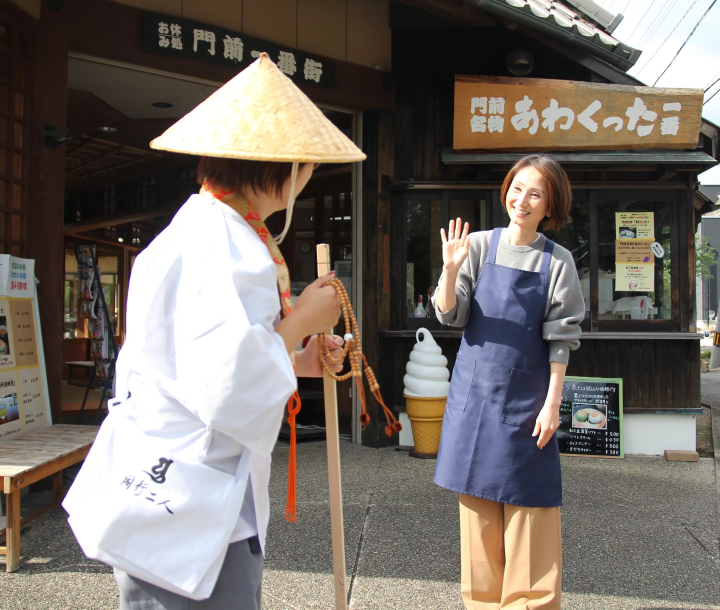
Whether you're visiting from across the ocean, attempting the pilgrimage for the first time, or celebrating a turning point in your life by walking, we hope that all travelers will take their first steps here and return with a smile on their face.
Naruto, the starting point of the Shikoku Pilgrimage.
Even today, the voices of "Have a nice day" echo in front of the gate.
[End]
The contents on this page may partially contain automatic translation.

![[ Naruto City , Tokushima Prefecture ] From Naruto, the Road of Prayer - The Heart and Landscape Connected by the Shikoku Pilgrimage -の画像](https://resources.matcha-jp.com/resize/720x2000/2025/11/12-249573.webp)



